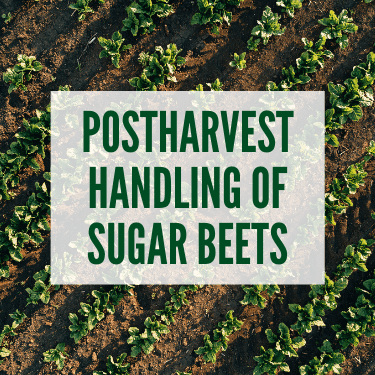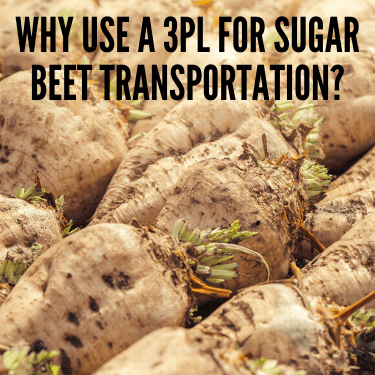Several regions in the United States do very well growing sugar beets. Maybe you’re a farmer or company that is now focused on sugar beet transportation and need to figure out how to go about it.
The good news for you is that sugar beet transportation is not a difficult field to become knowledgeable in, as long as you follow the rules of defoliation and package the beets well for shipping. Read more to learn about the humble sugar beet and the best practices to have success with the crop.
Most people know what a sugar beet is but for those who don’t, it is a plant that has a high level of sucrose, and is planted and harvested commercially to produce sugar.
For some regions in the U.S., sugar beets are an extremely important crop. Take the Red River valley that forms the border between Minnesota and North Dakota, for example. Even though the crop takes up less space than corn in that region, sugar beets have a greater economic impact and overall, prices have been pretty stable with sugar beets in comparison to other crops.
Sugar beets are only grown in three distinct regions of the United States:
Need help with freight shipping from Nebraska to Texas? What about freight shipping from Nebraska to Florida? See how a strategic partner like USA Truckload Shipping, powered by R+L Global Logistics, can scale a solution for you on these busy lanes.
These regions are ideal because they have the temperate climates that sugar beets do best in. Besides those weather conditions, sugar beets also need a sandy loam as soil to truly thrive in. This is a mixture of dirt, clay and sand. There’s less chance of diseases and insects interfering with the sugar beets in this area.
While the sugar is most commonly used, sugar beets are also utilized as livestock feed after processing. Molasses is also a by-product of processing sugar beets for sugar, and the molasses by-product is used in several different industries including in pharmaceuticals and alcohol.

The sugar beet will grow until it is harvested or until the plant encounters a hard freeze. Only then will the beet stop growing.
As soon as sugar beets are harvested, there is a process called defoliation that needs to occur immediately. As its name suggests, all foliage is removed from the plant as soon as possible to prevent new roots and leaves from sprouting. “Topping” is slang for defoliation since the top of the beet, where the leaves reside, are cut off.
Funnily enough, it’s thought that farmers don’t put as much care into their toppers, which does the job of defoliation, as they do the actual harvesters. If true, this is a mistake since sugar beets that are exfoliated properly yielded more and better sugar than plants that were not. Components on the toppers should be regularly maintained throughout each season so that the quality of the defoliated beet stays high.
Generally, beets need to be cooled down no later than 4 to 6 hours. However, beets that have been topped already do not need to be cooled down as rapidly and can be cooled within 24 hours. Cooling the beets slows down the root’s respiration rate and also its decay. Slowing both of these down will lead to a beet in better shape when it’s time to process.
Transporting beets is easy. They are loaded into a large commercial open bed truck and then driven to the processing plant. The bigger problem resides in what to do with the beets once they make it to a factory.
Processing plants are not as plentiful as they used to be and are also extremely expensive to build — roughly $100 million — so it’s no wonder that finding a newer one is nearly impossible. Also since beets are harvested on a seasonal basis, these factories run 24 hours a day, 7 days a week for 4 to 7 months at a time.
Once at the processing plants, the beets are washed and then sliced. Once this occurs, the resulting thin strips (called cossettes) are placed in a diffuser, which is a large tank, to squeeze out the raw juice.
From there, sugar and syrup come out as separate products and then the products are ready to be packaged and shipped.

The main reason to use third party logistics (3PL) for beet transportation is simple — the costs and usage associated with owning your own trucks.
The trucks used to move sugar beets to processing plants are typically only used at harvest time, and the rest of the time the trucks sit idle. Working with a 3PL could reduce the initial investment a new farm needs to make and could be more cost-effective in the long term than buying and maintaining your own trucks.
Instead of investing hundreds of thousands of dollars in trucks to move the beets, you can strike a fair deal with a 3PL and more easily pay per load than possibly be on the hook for another loan. You also don’t have expensive maintenance or repairs on vehicles to worry about if you go the 3PL route — that is the responsibility of the company providing the transportation services.
Once you’ve got your heart set on looking for sugar beet transportation, it’s time to call the experts at R+L Global Logistics to get those roots properly processed and passed on to retailers.
R+L Global Logistics has ample experience in transporting all kinds of vegetables, fruits and roots and will easily and quickly get your sugar beets — either whole or in their processed form as sugar — to their final destination.
We have expedited shipping for those times you need your freight transported even sooner than usual. Included with our normal service is our 99.5 percent on-time delivery rate and real-time freight visibility so you can track your shipment and also have the peace of mind that it will arrive before or on time.
So when you’re ready to enter the world of sugar beet transportation or shipping cantaloupe or more, look to R+L Global Logistics for a free quote. Receive a freight shipping quote and call us at (866) 353-7178.
R+L Global Logistics
315 NE 14th St., Ocala, FL 34470